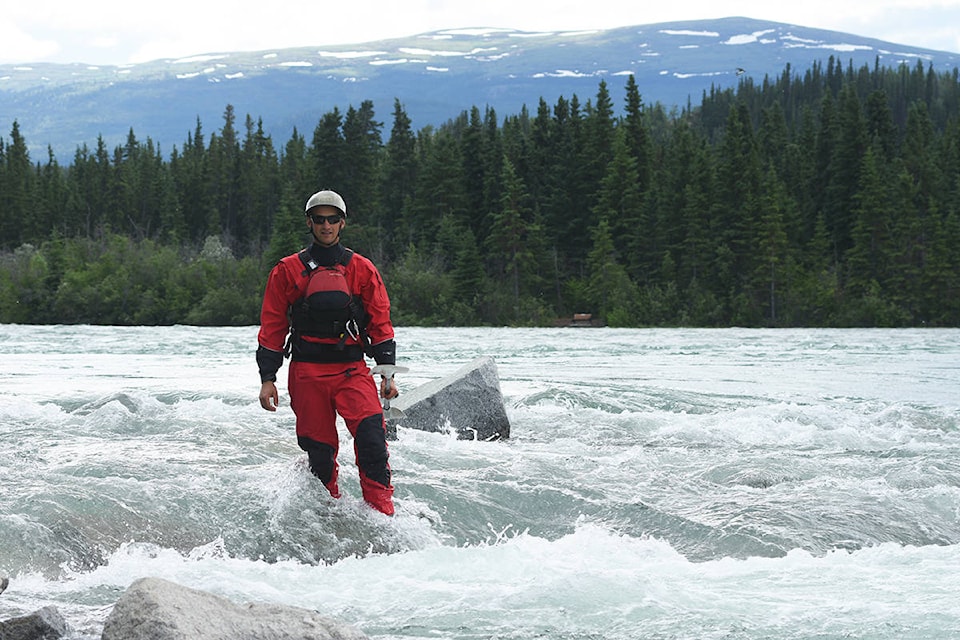The Yukon River roars through the centre of Whitehorse, pale blue with white capped waves lapping high up against its banks.
Like many of the rivers in the southern Yukon, it has swelled to well over its normal flow as melting snow is flushed down its course.
Kevin Daffe has been keeping a close eye on the rising rivers and the risks to recreational boaters that he says rise along with them. Daffe is a rescue technician and operates a commercial rafting, canoeing and kayaking business called Tatshenshini Expediting.
A born and raised Yukoner, he said he has never seen the rivers’ banks as swollen or their currents as raging as he saw at the end of June.
There are several hazards that come with high water which Daffe says anyone considering venturing out on the rivers should work into their risk assessment and seriously consider postponing.
He said a river running high conceals rocks, rapids and crashing waves – making it appear safer to some.
“They’re all flushed out. So people tend to think, ‘Oh, it’s an easier run.’ But in actual fact, it’s at a much, much more dangerous level, because there are no eddies, there’s no place to stop and reset,” Daffe said.
Daffe said that statistics from the American Whitewater Association show that 40 per cent of drownings among paddlers occur when rivers are in flood.
“I know how to manage those other risks, I know how to mitigate the risk. I can’t mitigate flooding and I just end up canceling things or choosing a different activity,” he said.
On a fast-flowing and featureless river, Daffe said a person suspended on the surface by their personal flotation device can quickly be swept downstream by the current.
| Kevin Daffe, a rafting company owner and water rescue technician says Yukoners should be aware of the hazards posed by the exceptionally swift rivers this Summer. (Jim Elliot/Yukon News) |
“They gulp a little bit of water on one wave and they gulp another and they never get a chance to go to shore so they drown with their head above the water. It’s called a flush drowning,” Daffe said.
Along with the threat posed by the speed of the current, Daffe said flooding rivers carry more trees and other debris which can hang up and create dangerous hazards called sweepers and strainers. A blockage on a fast-moving stream caused by a fallen tree can easily prove fatal for a canoeist or kayaker who gets hung up on it.
Rapid changes in a river’s features are another concern Daffe raised with the state of the rivers. He said the guides he works with who are running rivers regularly can negotiate the river’s changing shape or features but those taking an annual trip down a favourite river could find a very different waterway from the one they saw last.
He said gravel bars and other potential campsites important for multi-day trips are also likely to be inaccessible in the high water.
He said those who are planning to launch a boat on one of the rivers should seek out expert advice or Environment Canada water survey data to assess how fast their chosen river might be flowing. According to Daffe, the rivers are flowing fast — exceptionally fast.
He offered the example of the Wheaton River near Carcross in which he said a flow rate of 40 cubic metres per second (CMS) would be considered high. The Wheaton was flowing at nearly 90 CMS at the end of June, but remains powerful, flowing at 60 CMS on July 5. He said 90 CMS would be high for the Tatshenshini River which is now flowing at 140 CMS down from over 250 CMS.
He said historical data on flow rates and an awareness of how they compare to past years are valuable.
“So you’ll know last year your friends did the Big Salmon at ‘X’ CMS and they had a great time. If it’s 100 CMS higher, maybe don’t run it,” Daffe said.
He said there are always risks on the water but a hard look at the hazards before setting off is especially important under these conditions.
“I’m not telling people not to go out. It’s just, be very cautious, and then ask yourself is it worth it if something goes wrong?’”
As Daffe provides his warning, the Yukon government has also issued a high streamflow advisory for the Yukon River at Whitehorse.
“Record snowmelt-driven inputs to the Southern Lakes have resulted in rapidly rising lake levels and increased flows on the Yukon River between Marsh Lake and Lake Laberge,” their notice reads.
“Water velocities through Miles Canyon and downstream of the Whitehorse dam are high with dangerous currents. The high water levels are resulting in increased erosion along riverbanks and debris in the river.”
Contact Jim Elliot at jim.elliot@yukon-news.com
